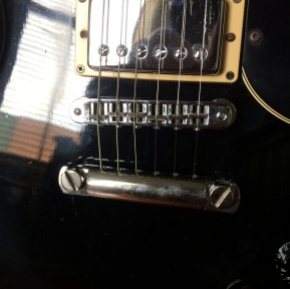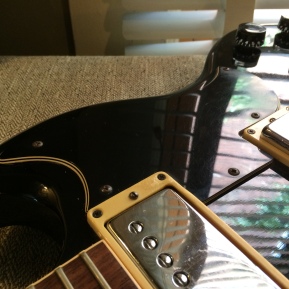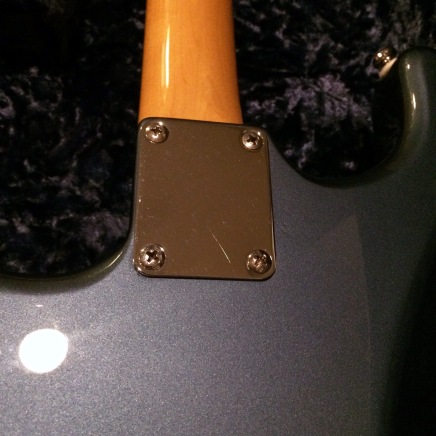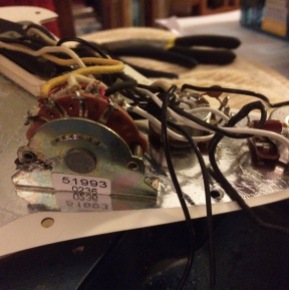I often feel that there are a lot of things that go into a beautiful new guitar that I don’t necessarily want to pay for, mostly the beautiful stuff. I’m a fan of function. Now not to disparage or discount the efforts of the fine craftsmen that put hour upon hour of excruciatingly skilled labor into making a Gibson Custom Shop Les Paul Reissue a true work of art, I have always felt that a lot of that effort has gone into making a guitar that really doesn’t sound significantly better, just more historically correct, or prettier. Nothing wrong with that, except for all of the working musicians out there that are not at a level to be blessed with discounted or free instruments from Gibson, are left to fend for themselves in a marketplace driven by many collectors and aficionado’s who, in my opinion, have driven the price of these instruments out of he realm of reality and the average player. People are buying these things as investments for christ’s sake, and not utilizing them for their intended purpose, making noise. And a good Les Paul makes one of the very best types of noise in many people’s opinion, mine included.
So, in an effort to see if I could make a Les Paul that would, in a blindfold taste test, provide those desirable noises, and feel close to as good, but not totally break the bank, I have assemble this rough equivalent of a ’57 Goldtop.
I started with a 2013 LPJ. Made for only two years, and rarely in Goldtop guise, this iteration of the Les Paul garnered exceptional reviews, especially considering it’s moderate price tag. Some feel Gibson discontinued it exactly because it competed directly with their own Studio, and Epiphone Les Paul lines. Whatever. It differs from other Les Pauls by having a maple neck, which many true Les Paul fans consider sacrilegious. For my part, I am happier about the possibly snappier tone and almost assuredly enhanced durability. Ever heard of a Les Paul falling over IN IT’S CASE, and coming out with a snapped off headstock? The bottom line is this is the least expensive Gibson Les Paul I could find that retains the traditional mahogany with maple cap body. That, in my opinion, is what makes it a legitimate Les Paul and worthy of use as a foundation.
I basically abandoned every other part of the LPJ offering, and throwing financial caution to the wind, built it back up with only the finest parts to hopefully create a high functioning Les Paul for well, less.
I have a thing for originality as far as sound goes. I believe their is a reason that the most sought after Les Pauls, the PAF 50’s models, are famous precisely because they sounded so amazing when played by the 60’s guitar icons that discovered their qualities first. Any “improvement” after that remains suspect. So with that in mind, I went after as true of a ’57 sound as I could. I’ll admit that cosmetic considerations intruded a bit right here. While the guitar was stripped, I carefully sanded the stain from the sides of the maple cap to subtly highlight it, and gave the whole thing a few coats of amber lacquer, followed by a coat or two of clear satin lacquer. The brassy shade of the satin gold finish and the barely finished mahogany back (which I personally think is beautiful in a raw, elemental way) were both warmed up considerably and I got a nice protective coat over the new maple “binding”. So on to things that really matter.
First off, I sourced a pair of Bare Knuckle Stormy Monday hand wound PAF clones. The reputation these guys have garnered is impressive, and besides that, I found a pair on craigslist locally for a decent price. Consensus on early PAF’s is that they are certainly not all created equal, but fall into a range. Some were Alnico II, some III, some V. Everyone seems to have their favorite nuance based on historic instruments owned and played by famous musicians, but the fact remains, there is no definitive PAF singularity. With that in mind, the Stormy Mondays seemed to be a great choice and the universe aligned to bring them into my hands at just the right time. They, like original PAF’s are not very “hot”. They utilize Alnico II magnets and one coil of each pickup is slightly overwound on purpose to get a bit of edge, like some of the legendary original PAF’s and Gibson’s own Burstbuckers. The lower output forces you to work the power stage of your amp a bit harder, and that provides an arguably different tone than just upping your gain.
Next, I got a ’50’s style Les Paul wiring harness from Emerson Custom. as I just can’t quite get used to the newer, plug and play, plastic circuitboard innards of many newer Gibsons. I’m an analog guy and to me metal is just plain more durable and made to last indefinitely if cared for properly. Maybe I’m wrong, but on this, I don’t care. I just feel that if it ain’t broke, don’t fuck with it. You think you can make a new paintbrush that will work better than the ones Van Gogh used?
Next came the bridge. The ABR-1 seems to be the necessary upgrade from the Nashville Tune-O-Matic. Of course me being me, I had to opt for a Callaham ABR-1 machined from billet. I told you already I threw financial caution to the wind. I figure if this thing doesn’t sound amazing when I’m finished, it won’t be the components’ fault. It’ll be either me or the basic PLJ body and neck, and at least I will have learned a lot about Les Pauls and have a pile of valuable parts left over. I also ended up after research, feeling the need for an aluminum stop bar tail piece, just like the 50’s, which I source from Kluson.
The nut was next, and me not really having the skills to cut and shape a bone replacement, I opted for a Graph Tech Tusq XL. A bit of sanding later it was in and fitting well. I have built a few partscasters and have always had great results with these nuts. If their info is even half accurate, they are a good choice for all but the most pure of purists.
At this point I have to admit that the purely functional improvements were complete. With the possible (argued by some) exception of the seemingly fine Kluson tuners, this guitar was good to go. For some reason though I couldn’t stop and ended up throwing on some Gibson Deluxe tuners and a set of creme colored Gibson plastics and pickguard. It just seemed to be begging to be dressed up in ’57 couture.
What I ended up with is a great sounding, great feeling Les Paul, for less than the price of a decent used Les Paul Standard. Any of the parts I used would be considered upgrades to even some Custom Shop instruments. I am in the process of getting it into the hands of some excellent Les Paul players that I know for their opinions. I’m hoping for some “blindfold taste tests” and will post an update on the results as soon as possible.
So leave your $6000 ’57 Reissue (R7) at home (or at the store) and beat this up instead. It won’t sound any different to the guy throwing up in the corner or the drunks at the bar, and the battle scars will just make it look better as it ages, just like you, you bare knuckle, rock -n-roll warrior you.
This instrument is currently for sale, so feel free to make an offer. I may not say yes, but I won’t get my panties in a wrinkle either. Thanks for reading.




































 The waterslide decal indicates a mid sixties reissue (way too clean to be an old one), so I’m guessing Japanese, but turning it over revealed that there is no serial number on the neck heel where it should be, or any indication that it might be a Custom shop instrument.
The waterslide decal indicates a mid sixties reissue (way too clean to be an old one), so I’m guessing Japanese, but turning it over revealed that there is no serial number on the neck heel where it should be, or any indication that it might be a Custom shop instrument.











 All in all, a REALLY nice guitar that has the solid feel and tone not often associated with non-Custom Shop instruments. The collector value is of course compromised by the AllParts neck and upgraded electronics, but I would challenge anyone to find a more desirable player on the showroom of your local guitar store. This thing just exuded solidity and substantial quality that can be rare in Stratocasters at times. So mystery solved (unless someone out there can educate me further). Thanks for looking
All in all, a REALLY nice guitar that has the solid feel and tone not often associated with non-Custom Shop instruments. The collector value is of course compromised by the AllParts neck and upgraded electronics, but I would challenge anyone to find a more desirable player on the showroom of your local guitar store. This thing just exuded solidity and substantial quality that can be rare in Stratocasters at times. So mystery solved (unless someone out there can educate me further). Thanks for looking



